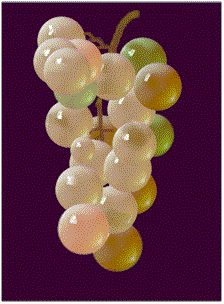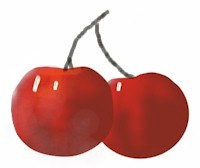|
A friend once wrote ... 'There is such evident sparkle in the eyes of intelligent people which if often missing in others, but always present to some degree. One of the things that led me to believe this is possible, was when I had the unfortunate experience of having to put one of my cats that had a fatal disease, to sleep. I can't tell you what a horrible experience this was as I loved this animal deeply. As the fatal injection was given, I actually watched the eyes go from sparkling to a dead grey. I have never gotten that image out of my mind.' In this lesson we are going to examine how to do the reverse ... to put a sparkle back into the eye.
To do this we must look at a white grape and a red cherry and see what makes them appear real. First the grape:
Many fruits have a light grey covering on their skin I call 'frosting'. This occurrs on the skin of most fresh stone fruit but is particularly noticeable on peaches, plums and grapes. I have added this frosting to Fig 2 above.
In the examples of the three grapes shown above I have altered their hue slightly to allow for various stages of ripeness. Also, since the 'frosting' is sometimes removed as the grapes are handled or moved about I have cleared certain areas allowing the smooth skin to show through. This has the effect of emphasising the frosted areas even more.
Now all we need do is assemble our bunch in as a convincing manner as possible (see below). This should not be difficult for those partial to eating grapes.
The cherry also has similar qualities to the grape though without the transparency.
Then ... below they are assembled with a few 'realistic' toutches. Most of the frosting is removed and the exposed shiny bright red skin makes the 'highlight' sharper. There is no 'transparency' in the cherry. You will no doubt remember the lesson on the 'pearl' which was an object with similar non-transparency.
With the grape and the pearl (or cherry) we have created the two spheres that together will allow us to understand, paint and add the sparkle we want to the the human eye.
To see how this is achieved you must go to the next page. |
||||||||||||||









